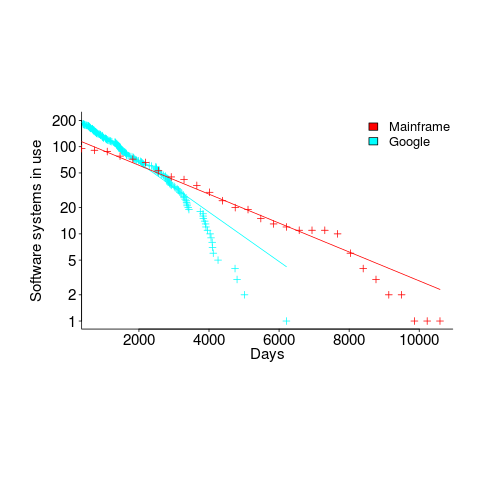Half-life of software as a service, services
How is software used to provide a service (e.g., the software behind gmail) different from software used to create a product (e.g., sold as something that can be installed)?
This post focuses on one aspect of the question, software lifetime.
The Killed by Google website lists Google services and products that are no more. Cody Ogden, the creator of the site, has open sourced the code of the website; there are product start/end dates!
After removing 20 hardware products from the list, we are left with 134 software services. Some of the software behind these services came from companies acquired by Google, so the software may have been used to provide a service pre-acquisition, i.e., some calculated lifetimes are underestimates.
The plot below shows the number of Google software services (blue) having a given lifetime (calculated as days between Google starting/withdrawing service), mainframe software from the 1990s (red; only available at yearly resolution), along with fitted exponential regression lines (code+data):

Overall, an exponential is a good fit (squinting to ignore the dozen red points), although product culling is not exponentially ruthless at short lifetimes (newly launched products are given a chance to prove themselves).
The Google service software half-life is 1,500 days, about 4.1 years (assuming the error/uncertainty is additive, if it is multiplicative {i.e., a percentage} the half-life is 1,300 days); the half-life of mainframe software is 2,600 days (with the same assumption about the kind of error/uncertainty).
One explanation of the difference is market maturity. Mainframe software has been evolving since the 1950s and probably turned over at the kind of rate we saw a few years ago with Internet services. By the 1990s things had settled down a bit in the mainframe world. Will software-based services on the Internet settle down faster than mainframe software? Who knows.
Based on this Google data, the cost/benefit ratio when deciding whether to invest in reducing future software maintenance costs, is going to have to be significantly better than the ratio calculated for mainframe software.
Software system lifetime data is extremely hard to find (this is only the second set I have found). Any pointers to other lifetime data very welcome, e.g., a collection of Microsoft product start/end dates 🙂
Hi Derek,
I haven’t seen your post when I was writing mine about the same topic: https://www.krivaltsevich.com/articles/the-half-life-of-software
The second data source I use is Wikipedia’s section of discontinued software.
Cheers,
Dmitry
@Dmitry
Thanks for the link to your post, with the new data.
Given your interest in data, you might like to look at the draft of my evidence-based software engineering book.
Good luck with your blog.